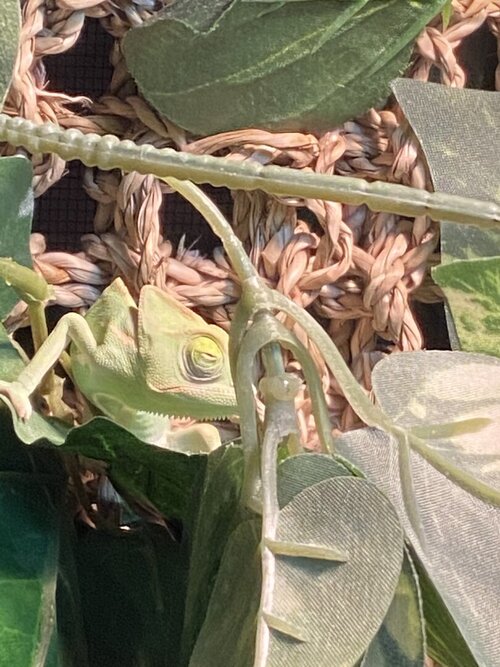1221cham
New Member
We have a 14 week old male veiled Chameleon. On 1/19, we noticed his right eye was squinted-like he wouldn’t open it all the way. I had read sometimes they do this to clean the eye, so I didn’t think too much about it. On 1/20, I came home from work and it was worse. He just kept the eyelid closed and he kept leaning to the right side. He also did not eat any of the crickets we put in his enclosure. Later in the evening he turned darker green and puffed up-but I think he was just aggravated because I was misting his cage more often than normal. However, I was pretty concerned-mainly because of how he was leaning, so I called the vet but they can’t get me in until next week.
Today, his eye looks a little better, and I don’t think he’s leaning anymore, but often he will squint that right eye for a minute or two then open it for a few minutes then squint it again. We are new to this, so is this just something they do at times? Should I be concerned and follow through with the vet or just know they do this from time to time? I’ve attached a picture of what his eye looks like when he squints it.
Some specifics:
14 week male veiled chameleon
Feed-feeder crickets, gut-loaded with Repashy bug burger, tossed with Repashy calcium plus LoD. Recently also introduced meal worms.
16x16x30 mesh terrarium. Using a mixture of fake vines and real pothos plant. Also several sticks and a rope bridge for him to climb. We clean the enclosure every two weeks.
Using a Flukers 75 watt basking bulb and a Reptisun 13 watt 5.0 UVB bulb.
Also confused as to how long the lights should stay on because I have read conflicting info. We had been leaving both lights on all the time, but then read we should turn them off at night. When his basking bulb isn’t on though, he puffs up and turns really dark-almost black.
Enclosure stays around 80-85 degrees at the top of the cage (temp directly under the basking bulb is probably higher) and between 60-70 at the bottom of the enclosure. Humidity is sometimes an issue as we use wood burning stove that zaps a lot of humidity from our house, but stays between 40-60% most days and sometimes has been as high as 80% if we aren’t running our stove. We mist the cage for about 1-2 minutes several times a day and did add a humidifier in the room.
He has already went through one shed cycle since we got him in December, so I don’t think this is related to him getting ready to shed.
Any info is appreciated! Thanks!
Today, his eye looks a little better, and I don’t think he’s leaning anymore, but often he will squint that right eye for a minute or two then open it for a few minutes then squint it again. We are new to this, so is this just something they do at times? Should I be concerned and follow through with the vet or just know they do this from time to time? I’ve attached a picture of what his eye looks like when he squints it.
Some specifics:
14 week male veiled chameleon
Feed-feeder crickets, gut-loaded with Repashy bug burger, tossed with Repashy calcium plus LoD. Recently also introduced meal worms.
16x16x30 mesh terrarium. Using a mixture of fake vines and real pothos plant. Also several sticks and a rope bridge for him to climb. We clean the enclosure every two weeks.
Using a Flukers 75 watt basking bulb and a Reptisun 13 watt 5.0 UVB bulb.
Also confused as to how long the lights should stay on because I have read conflicting info. We had been leaving both lights on all the time, but then read we should turn them off at night. When his basking bulb isn’t on though, he puffs up and turns really dark-almost black.
Enclosure stays around 80-85 degrees at the top of the cage (temp directly under the basking bulb is probably higher) and between 60-70 at the bottom of the enclosure. Humidity is sometimes an issue as we use wood burning stove that zaps a lot of humidity from our house, but stays between 40-60% most days and sometimes has been as high as 80% if we aren’t running our stove. We mist the cage for about 1-2 minutes several times a day and did add a humidifier in the room.
He has already went through one shed cycle since we got him in December, so I don’t think this is related to him getting ready to shed.
Any info is appreciated! Thanks!







